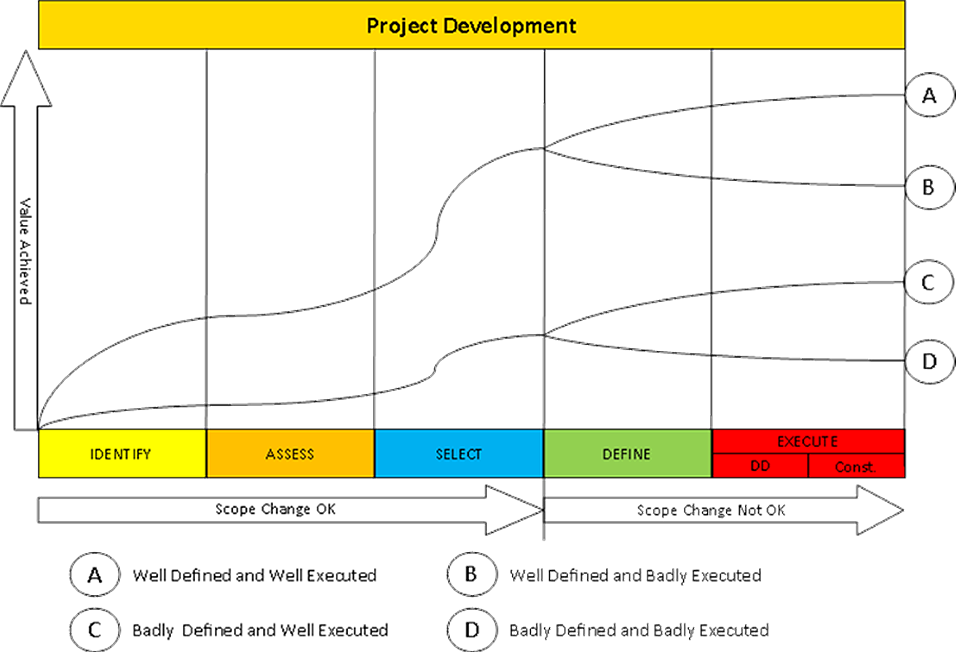The following sections provide an overview of the project delivery process that Flex projects uses as the basis of our project delivery work. It is as per our tag line not the same for every project and is scaled appropriately to the needs of the individual client.
For Flex Projects we are happy to use either your system or our approach. It also does not matter where you are with delivering your project as we can slip seamlessly into your organisation and support you and your team in delivering the value you are looking for in a manner that suits you.
We have also found that the best way to understand each other and how we both work is to talk and discuss our objectives.
Therefore if the below does not provide what you are looking for lets have a coffee and discussion.
Project Lifecycle
A clear understanding of the project lifecycle is vital to getting the best out of your project and we understand the value a good front end process provides in ensuring that you project delivers on what it needs to and that you get out the value you are looking for.
By following a right sized process we have found you get you and the entire team get a clear understanding of:
- What you are looking to achieve
- Why you are undertaking the work
- What you need to do to get there
- What you are “and importantly” are not going to do
- What your risks and opportunities are
We have also found that Engineers and Contractors have a clear scope and set of boundaries which is important in controlling scope growth and costs.


Identify the Opportunity
Identifying and clearly communicating the opportunity that the business faces is critical to achieving the optimal solution and realising its value. A well executed and right sized identify section at the start of a project provides all in the project a clear understanding of:
- What the project is looking to address guides the team in the right direction
- An understanding of the budget constraints (how much money is potentially available) which gets the team thinking on the correct scale.
- An understanding of the stakeholders to be engaged with and their impact on the project
- an understanding of what value looks like and the factors the influence success
Concept Identification & Feasibility
A well executed and right sized concept identification and feasibility assessment phase(s) consider the opportunity to be addressed, considers the key factors in addressing the opportunity, considers the steps that can be taken to address the key factors, creates a wide range of options to create varied solutions, culls out the outliers and why they were dismissed, provides workable (in principle) options for Feasibility Assessments.
These options can then have their feasibility considered to:
- Validate the option is workable
- Identify and address high level risks
- Investigate and plan mitigations to the key risks and when they will be addressed
- Provide indicative layouts for the options and how they fit within the overall scheme.
- Allow initial Stakeholder discussions on what is being considered to address the opportunity.


Selecting the preferred solution
Selecting a preferred solution does not mean selecting the solution that meets all the factors identified in the ideal way. Instead it should identify the value break point and identify the “Fit for Purpose” that solution that provides the right balance for the business including addressing (if not previously) “Can we do nothing?”.
The project should ideally have undertaken preliminary engineering and design on the high level items that can affect the success of the project to ensure that there is no big surprises down the track when costs of rework and changing track is considerably more expensive.
By undertaking this well the project should be able to show and communicate:
- What was considered and selected
- Why the option was selected including being able to discuss the key differentiators between the options
- How fully the project is going to address the opportunity 100% why not including being able to discuss cost against value.
- If it can do nothing
- That the high level technical, regulatory and financial risks are addressed.
- Define & Detailed Design
Define and Detailed design are the point in a project where the costs significantly start to increase and generally the point where changing course can be complicated. They should also ideally be undertaken in two steps rather than all at once.
Define
The first part of significant engineering is generally Define which is used to
- confirm the size for major items for each discipline
- validate the interfaces between scopes or vendor supplied pieces of equipment
- validate constructability
- final confirmation with stakeholders related to operability
- Address medium technical risks
- assess missing information and agree with client who and how these will be addressed.
- Potentially engage with contractor(s) on ECI if this is to be used
- Procure long lead items
This is also the phase in which the engineering consultants (if used) understanding of the scope is tested and most critically what is in scope and what is out of scope. It also allows a clear understanding on both sides on who is to mitigate the remaining risks (Client or Others).
Depending on the level of detail required in Execution this phase is also key to communicating to the Engineering and Design team the expectation for the level of detail in the technical documents.
Detailed Design
Detailed design would be where 80% of the engineering and design effort is undertaken and is critical to ensuring the installation / construction contractor can accurately price up the work and put appropriately considered methodologies together for how the project will be executed.


Execution / Construction
Management of the execution or construction phase of a project as it is the key to the external reputation side of a project as it is the phase that most people see. It is also the part where the fruits of you previous work comes to reality and any issues are ironed out. On top of that it is also the part where the value is realised and it becomes evident if your project is going to deliver the value envisaged at the start for the money agreed to be spent.
For may organisations it is also the most time sanative part of the project as it is the part that has the greatest impact on their operations, which is why it gets the most focus.
However, planning and following a good project development process as outlined in the sections above should along with some careful execution and if needed shutdown planning enable even this phase to move smoothly and with as least disruption as possible. Another benefit of following a good project development process is that the operations team (most affected by the construction phase) will most likely have undertaken some planning themselves to allow them to work around the construction or implementation activities as thy will understand the objective and how it will be implemented or phased in.
